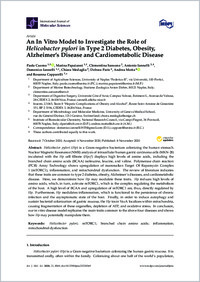An In Vitro Model to Investigate the Role of Helicobacter pylori in Type 2 Diabetes, Obesity, Alzheimer's Disease and Cardiometabolic Disease.
- Cuomo P Department of Agriculture Sciences, University of Naples "Federico II", via Università, 100-Portici, 80055 Naples, Italy.
- Papaianni M Department of Agriculture Sciences, University of Naples "Federico II", via Università, 100-Portici, 80055 Naples, Italy.
- Sansone C Department of Marine Biotechnology, Stazione Zoologica Anton Dohrn, 80121 Naples, Italy.
- Iannelli A Department of Digestive Surgery, Université Côte d'Azur, Campus Valrose, Batiment L, Avenue de Valrose, 28-CEDEX 2, 06108 Nice, France.
- Iannelli D Department of Agriculture Sciences, University of Naples "Federico II", via Università, 100-Portici, 80055 Naples, Italy.
- Medaglia C Department of Microbiology and Molecular Medicine, University of Geneva Medical School, rue du Général-Dufour, 1211 Genève, Switzerland.
- Paris D Institute of Biomolecular Chemistry, National Research Council, via Campi Flegrei, 34-Pozzuoli, 80078 Naples, Italy.
- Motta A Institute of Biomolecular Chemistry, National Research Council, via Campi Flegrei, 34-Pozzuoli, 80078 Naples, Italy.
- Capparelli R Department of Agriculture Sciences, University of Naples "Federico II", via Università, 100-Portici, 80055 Naples, Italy.
- 2020-11-11
Published in:
- International journal of molecular sciences. - 2020
English
Helicobacter pylori (Hp) is a Gram-negative bacterium colonizing the human stomach. Nuclear Magnetic Resonance (NMR) analysis of intracellular human gastric carcinoma cells (MKN-28) incubated with the Hp cell filtrate (Hpcf) displays high levels of amino acids, including the branched chain amino acids (BCAA) isoleucine, leucine, and valine. Polymerase chain reaction (PCR) Array Technology shows upregulation of mammalian Target Of Rapamycin Complex 1 (mTORC1), inflammation, and mitochondrial dysfunction. The review of literature indicates that these traits are common to type 2 diabetes, obesity, Alzheimer's diseases, and cardiometabolic disease. Here, we demonstrate how Hp may modulate these traits. Hp induces high levels of amino acids, which, in turn, activate mTORC1, which is the complex regulating the metabolism of the host. A high level of BCAA and upregulation of mTORC1 are, thus, directly regulated by Hp. Furthermore, Hp modulates inflammation, which is functional to the persistence of chronic infection and the asymptomatic state of the host. Finally, in order to induce autophagy and sustain bacterial colonization of gastric mucosa, the Hp toxin VacA localizes within mitochondria, causing fragmentation of these organelles, depletion of ATP, and oxidative stress. In conclusion, our in vitro disease model replicates the main traits common to the above four diseases and shows how Hp may potentially manipulate them.
- Language
-
- English
- Open access status
- gold
- Identifiers
-
- DOI 10.3390/ijms21218369
- PMID 33171588
- Persistent URL
- https://folia.unifr.ch/global/documents/100655
Statistics
Document views: 4
File downloads:
- fulltext.pdf: 0
